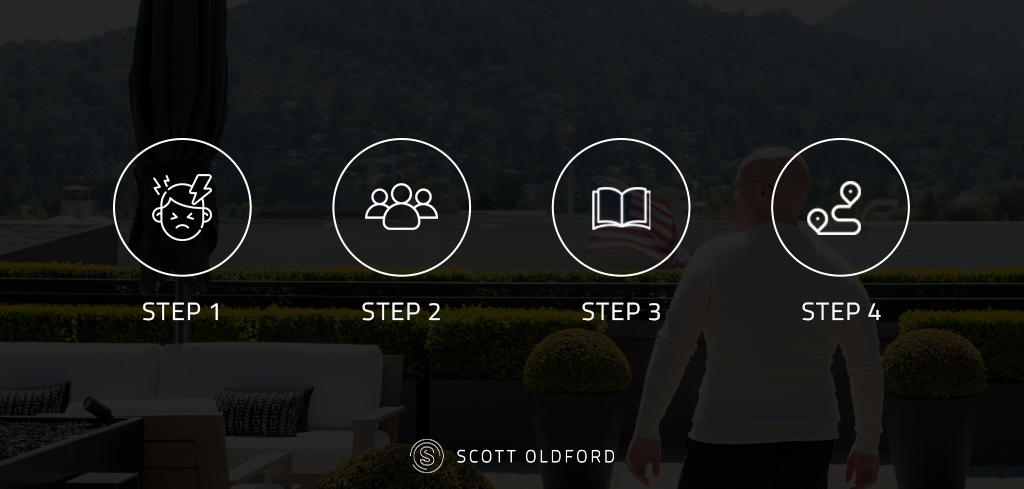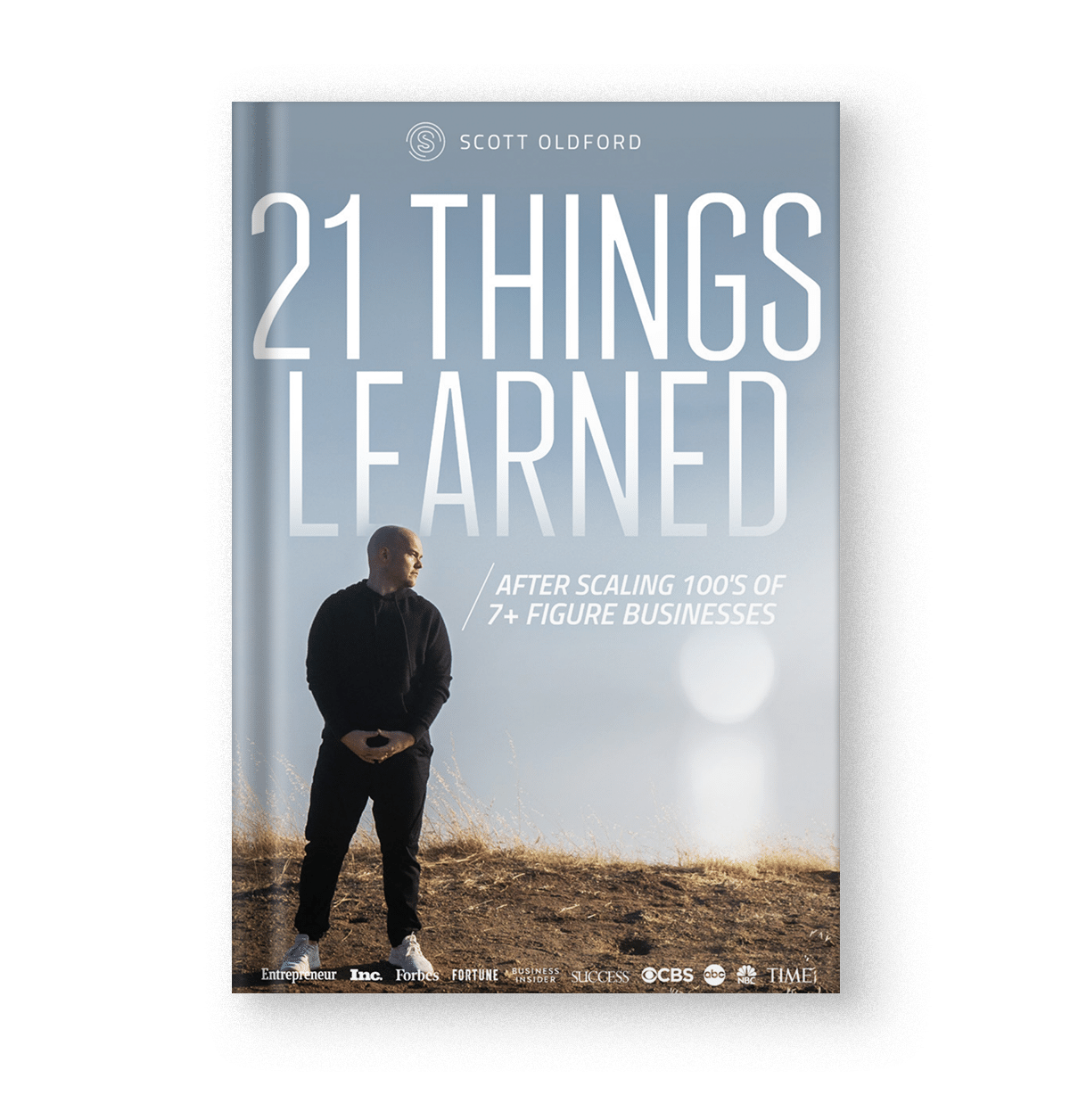
It’s frustrating!
You get traffic. You have a solid offer—one you know people should buy!
But it’s getting harder to persuade them and convert this traffic to take action…
So what do you do? Well, the answer may be easier than you think.
It comes down to your sales copy. You have to write a persuasive sales copy.
Learning how to write persuasive sales copy is a skill every entrepreneur needs. It’s the only way to convert traffic, build trust, and persuade people to take action in today’s fast-paced, hyper-competitive world.
Yet this is a skill almost every entrepreneur I come across resists. I get it. I used to, too!
Often, this resistance centers around a few common excuses:
- They don’t like to write!
- They don’t have the time!
- They don’t see the value in it (can’t they just hire someone else to write copy?)!
As with any excuse, we can kid ourselves into thinking these are valid.
It isn’t that they’re not true… the point is you have to see past these as an entrepreneur.
In this article, I’ll explain why—as well as show you how to write persuasive sales copy in four simple steps (no matter what experience you have).
Here’s how…
Table of Contents—How To Write Persuasive Sales Copy
- How To Write Persuasive Sales Copy
- Introducing This 4-Step Sales Copy Method
- The Benefits of Writing Persuasive Sales Copy
- Your Next Steps…
How To Write Persuasive Sales Copy
If you don’t consider yourself a good writer, don’t worry, neither do I—at least not in the traditional sense.
At school… well, let’s just say I wasn’t the best student. I always struggled to focus. Reading and writing didn’t come easy for me.
Grammar in particular held me back.
It remains a struggle. Yet I no longer worry about this.
Don’t get me wrong, it used to. Mainly because I told myself how terrible I was at writing. I felt vulnerable each time I tried to. So I avoided it.
Not anymore. Today, I appreciate there’s a difference between a good writer and someone that can write good persuasive copy.
I can tell engaging stories.
I can hook my audience with compelling copy.
I can speak to those I serve in a way that works for me (and for them).
None of this just happened. I had to work at it. For starters, I had to overcome those beliefs and excuses. It was a mindset issue. Not a skillset one.
As I’m sure you know, most of your problems—in business and in life—come down to mindset.
Beyond that, I had to find a way to write that set me up for success.
That’s what I want to share with you today…
a simple 4-step method you can use to write persuasive sales copy no matter your industry, situation, or experience as a writer—even if English isn’t your primary language.
With this process, you’ll lay the foundations so you know what you need to write before you write it. This saves you time. It produces less stress as you stare at the blank screen. You become more productive.
To some extent, every entrepreneur needs to learn this.
It isn’t that you should write all your copy (you shouldn’t… where possible, hire others to do it!!)
BUT the power of persuasive sales copy doesn’t end on a sales page. It changes how you write:
- Emails
- Social media posts
- Video scripts
- Webinars, workshops, and much more
Beyond this, you get to understand your audience on a deep level. It transforms how you communicate with them. This is a game-changer! It’s an unfair advantage that sets you up for huge growth. Because once you “get” your audience on a deep level, you can serve them like nobody else in your niche can.
You become the “go-to” authority they need.
And it all begins with this simple 4-step method…
Introducing The 4-Step Sales proccess for a persuasive Copy Method

Before we dive into this method, it’s important to reiterate that this on its own WILL NOT help you.
This method gives you the skills you need to write persuasive sales copy.
But that means nothing if your beliefs, fears, and mindset hold you back.
So if those excuses I mentioned at the start of this article refuse to budge, now is the time to work on yourself. This method helps regardless. But it only acts as a bandaid if your beliefs remain a roadblock.
With this in mind, check out reWIRED: The 7-Figure Mind.
Okay, so that method I keep talking about… what is it and how does it work?
This is something me and my team have perfected over the years (a specific shoutout to Kameron Snow, who acted as my head copywriter for many years). It didn’t just happen. Through lots of experimenting, I’ve honed in on what works—and what doesn’t.
And although this method works for anyone in any industry, it’s important you tailor everything around you and your unique situation. This isn’t some copy-and-paste template you can use. What I’m about to share gives you access to the foundations of compelling, persuasive sales copy.
Let’s dive in…
Step 1: The Pain/Problem
The first step to writing persuasive sales copy is to identify the problem you need to solve.
- What pain does your audience feel?
- What desires motivate them to change?
- What holds them back?
In most cases, someone either desires something they don’t have or want to remove something they do. To some level, all problems come down to this. Your job is to figure out what it is.
The caveat is that their actual problem may not match their perceived one.
In fact, in most cases, it won’t—but more on this in a second.
First, why is this important? Why do you need to identify their pain and get this across in your sales copy? It comes down to trust, and your audience’s desire to feel understood.
Whether they know you or not, they want to trust you “get” them.
By identifying their problem and expressing it in a relatable way, they instantly believe they’re in the right place. You’re speaking to them. You once stood in their shoes. You’re not writing about a general somebody… it feels like you directly write to them.
Issues You Need To Overcome:
Identifying your audience’s core problem is easier said than done because:
- You may solve many problems, so are unsure which to focus on…
- If you do know the problem you solve, you likely struggle to talk about it in a coherent way…
- When you do talk about it, it’s easy to focus more on your solution than the pain they feel…
Plus, your audience’s actual problem and the one they think they have often don’t align.
All these create a big issue for you. The point of this stage in the process is to reassure your audience they’re in the right place. If you confuse them, they switch off. If you focus too much on their actual problem (instead of the one they think they have), they move on.
You have to get on their level and make sure you tap into the pain they feel (or desire). Remember, they have something they want to get rid of or don’t have something they’d like.
This is what you need to speak to.
This is what you need to highlight.
These are the feelings you need to trigger!
How To Identify Your Problem:
So, how do you do this? For starters, take a step back and reflect:
- What’s hurting in your audiences’ life right now (what keeps them up at night)?
- Alternatively, what does your audience desire (what do they dream about)?
- Where does this pain (or desire come from)… Beneath the surface, what’s missing?
As the expert and individual further long than them, you likely know their root cause problem. This is good, and later in this process, you need to move them from their perceived problem to the actual one.
Yet you first need to step into their shoes.
Get on their level. Appreciate what they’re going through.
Until you do, you’ll never build that all-important trust; they simply won’t feel like you can help them.
**Tip** if you already have an existing audience, reach out to them and ask (via email, social media, your funnel, etc…). Re-listen to old sales calls and pick up on pain patterns. Sometimes you have to read between the lines, but your audience often tells you what’s hurting them.
Example:
To help illustrate this, here’s an email example that shows these four stages in action.
Starting with this first step, their pain/problem…
Hi [name], I’d like to ask you a question I always ask my one-to-one clients. Most of them have the same response, so I’m wondering if you feel the same as them…
At the end of each month, how do you feel when you do your monthly finances?
If you’re like most of my clients, you’re saying something along the lines of stressed, overwhelmed, and on-edge.
It doesn’t seem to matter how much money you make, it’s always a scramble to pay the bills, your team, your ad spend—plus you always have new ideas to invest your money into.
It’s stressful, right?
And let me ask… do you, like my clients, assume the problem is cash flow?
That if you just make more money or bring in new clients that it will solve your problems?
If so, I have something for you—although it’s a harsh truth you may not be ready to hear.
As you can see, the aim here is to clearly highlight their pain, hint that there’s more to the problem than they think, as well as reassure them they aren’t alone.
This leads to the next step where you focus more on who they are…
Step 2: Who They Are
Now you better understand your audiences’ problems (perceived and real), you need to better understand who they are.
- What demographics do they fit into?
- What interests do they share?
- How do they get their content (and how do they like to consume it)?
- Are they in the Sidewalk, Slow Lane, or Fast Lane?
This isn’t something you need to know for your sales copy. This is something you need to know for your business, period! Who your audience is is everything.
You need to know who they are on a deep level.
Not just what their problem is, but how their personality aligns with this.
Issues You Need To Overcome:
Crafting your ideal avatar isn’t always easy because:
- You may have several avatars relevant to your business/offer…
- Choosing the right avatar may feel like a huge risk (you want to spread your risk)…
- Highlighting the right information creates a headache (there’s so much data out there)…
For starters, your business *can* have more than one avatar.
But when writing good, effective sales copy, you need to write for one person.
If you don’t, you end up with bland content that doesn’t trigger those all-important feelings mentioned in stage one. This kills your copy. So even if you have multiple avatars, choose one.
As for the data and information you can focus on, don’t get hung up on standard demographics like gender, age, and location. These can help, and you need to know the essentials. Yet the most important information is the psychographics that determines who they are:
- Personality traits
- Lifestyle and interests
- Values
- Behavior (the content they consume, and where they consume it)
- Beliefs
- etc…
Beyond this, money always comes into your avatar. After all, you need to appreciate what your audience can afford and what their problem costs them.
The better you understand all this, the more tailored and relatable your sales copy is.
How To Craft Your Avatar:
So, how do you begin to craft your avatar? Now is a good time to think about:
- Who you’ve enjoyed working with in the past, and who you’ve had the biggest impact on
- What your own story is, and who matches the journey you’ve been on
- What you bring to the table (your skills, UVP, etc…) and who this is relevant to
Again, you likely already have a good idea of who your avatar is because you’ve created one (or several) for your core business. If this is the case, expand on it and dive deeper so it’s relevant for your copy.
The whole point here is to write something for someone.
Example:
Following on with our email example from earlier, this is how it continues…
If so, I have something for you—although it’s a harsh truth you may not be ready to hear.
Before that, I want to make sure this is for you.
Because what I’m about to share isn’t for everyone!
You have to be ready to hear this, and you have to be at a stage where you’re ready to break through the glass ceiling in front of you and transform your business so you no longer struggle to keep up no matter how much money you make!
If you’re still figuring out your product, this isn’t for you.
If all you want to do is hustle and say yes to every opportunity, this is not for you.
If you aren’t ready to question your beliefs and level up… this ain’t for you.
But if you’ve hit the point I did a few years ago, what I have to say may change your life.
As you can see, this section of the email focuses on who they are as a person—as well as the situation they’re in. The aim here is to make them feel like they’re in the right place; that you understand who they are and where they are, which you dive into further next…
Step 3: Your Story
Now is the time to step away from your audience and dive deeper into YOU.
- What’s your story?
- What obstacles have you overcome?
- What results have you experienced (and successes along the way)?
- Where did this all begin and how did your journey ignite (ie: your origin story)?
This is something I see many entrepreneurs struggle with because 1) they don’t feel like they have an interesting story, and/or 2) they feel uncomfortable sharing too much of themselves—preferring to hide behind their business’ brand.
This is something you need to move past. Your story is one of the most valuable assets you own. Your competitors can replicate your offer and solution, but never your story.
Plus, your story helps create that all-important connection between you and those you serve!
Through your story, they can relate to you. You were like them. You suffered the same pain. Stories are what we trust most in this world. And because the world’s full of options, we subconsciously use stories as a measuring stick.
Issues You Need To Overcome:
As I say, many entrepreneurs struggle to create and share their stories because:
- You don’t want to feel vulnerable and share something personal…
- You may struggle to be seen, preferring to hide in your brand’s shadows…
- You don’t know which story (or part of your story) to share…
To begin with, a good rule of thumb to follow is to share scars, not open wounds. Scars represent a time in your life that hurt but you’ve since recovered from it. You can look back in hindsight and offer valuable advice—whereas open wounds continue to hurt; you’re still in the middle of it.
Another important perspective is that although this is your story, it doesn’t have to only focus on you. Use your story to build a bridge between you and your audience.
Make them the lead character.
This way, you play a supporting role—referencing your journey to make your story more relatable.
Relatable is a keyword here… any story you share needs to relate to your avatar and their problem. You may have an inspiring journey, but if it isn’t one your audience can relate to, it won’t hit home.
Remember, the whole point is to build trust and rapport.
A cool story that means nothing to them doesn’t help anyone.
How To Create & Share Your Story:
So, how do you create and share your story? Start by:
- Highlighting any relevant experiences that demonstrate you’ve already done the work
- Finding results that prove you’re a credible source and coming from a place of authority
- Honing in on that bridge that connects who you were with who your audience is today
Remember, any story (or part of your story) has to feel relatable to your audience.
This isn’t about you, even though it focuses on your story.
Instead, only focus on the parts of your journey that help connect you with those you serve.
Example:
Revisiting our email example from before, this is how it continues:
But if you’ve hit the point I did a few years ago, what I have to say may change your life.
Not long ago, I found myself in a lot of debt.
It was a stressful time, so I buckled down and started a new business.
It grew… and grew… and grew! Soon, I escaped debt. Before long, I made more than I ever had in my life. But here’s the thing… I felt the same as I always did. I was out of debt. But it didn’t feel like it. Each month, I felt stressed, on-edge, and anxious—always struggling to keep up.
I kept making more money. We scaled and grew and broke through glass ceilings.
Yet nothing seemed to change. More money didn’t seem to make any difference.
I felt lost. I figured I would eventually hit a point where the problems would disappear…
That there was some magical amount of money that would change everything.
Yet I never hit it.
I now know that “magic number” doesn’t exist.
And I learned this after going through a very specific process!
As you can see, this part of the email dives deeper into my story.
Yet its sole purpose is to show the reader that I once felt like they do now.
It makes me relevant and relatable, ensuring they’re ready to hear what comes next…
Step 4: The Solution
The final step of this process is the ability to effectively communicate your solution.
- How do you specifically help your audience?
- What do they get from your offer?
- What benefits does this offer provide?
On the surface, this may seem obvious and easy to achieve—after all, your solution centers around your product/service/offer. However, the point here is to clearly and effectively communicate it.
Not the various features involved, but the benefits behind these!
This is where many entrepreneurs fall short—often because they’re too close to their offer.
What matters more than anything is to step into your audience’s shoes and relate your solution to them, their problem, and the situation they’re in.
This isn’t about you. It’s not even about your solution…
It’s about how it provides your audience value!
Issues You Need To Overcome:
This is the stage most entrepreneurs think they know the answer.
Yet once they dig in it’s not as simple as they thought because:
- You may not know how you specifically help your clients; each project’s different, so you just go in and create positive results…
- You struggle to communicate what you do; at least, in a clear, concise way…
- You’re unsure if what you offer is something your audience actually needs (it helps, but does it transform?)…
To some degree, everyone struggles when they reach this stage. You know your business (and what you offer) better than anyone. You’re good at what you do. You don’t necessarily have a system or process… you just do the work and create some wins.
And even if you do have a system, it’s easier said than done to communicate it!
This is why this final step is so important because it forces you to dive deep. Your solution is only valuable if it makes sense to the person you offer it to. If they don’t understand it… don’t “get” it… don’t think it relates to them… you’ll never get them on board.
Great sales copy often falls short here.
It’s the final hurdle that trips many up!
How To Figure Out Your Solution:
For starters, there’s one of two things you have to do here:
- Figure out if your solution/offer actually works
- If it does, figure out a way to effectively communicate this
If your offer doesn’t produce results, you may need to go back to the drawing board—not with your sales copy, but rather your product as a whole.
Assuming your offer does help your audience, it’s a case of communicating this the right way.
You need to approach this by considering:
- How you currently deliver results (is there a process, system, methodology you follow?)
- Different phases/stages your clients go through (ie: major milestones)
From here, you need to name these stages or methodology as a whole. A good example of this is the ROI Method I built a few years ago: Relevance, Omnipresence, and Intimacy.
This method didn’t just happen. In the beginning, I found myself working through this process and helping clients do the same. But it had no name. I just did it; it’s what I knew to do.
So I stepped back and thought about the different phases…
I considered the major milestones and the details of each phase…
I let my imagination roam until I landed on a memorable and clear name: R.O.I.
Why is this important? Because there’s too much information out there as it is. If you can’t clearly explain your solution in seconds, you’ll never capture attention—let alone keep it.
Having a clear methodology with a clear name that makes a clear promise is the difference between success and failure. It isn’t about fancy branding or having a name you can trademark. It’s a literal building block to help your copy stand out and do its job.
Example:
Returning to our email example, this is how it ends:
I now know that “magic number” doesn’t exist.
And I learned this after going through a very specific process!
It’s a process that not only improved my cash flow and helped me take charge of my finances but also fixed a huge mindset issue I had dragged alongside me since childhood.
Within a matter of weeks, everything seemed to change.
Not just finances, either… but my whole relationship with money!
I’ve never looked back.
And it’s something that’s transformed the lives of many of my clients.
I’m running a private workshop later this week that breaks this process down for you—as well as showing you what to do next so you can change your own relationship with money.
It’s called The 60 Day Finance Upgrade!
All the details are on this page, including the workshop’s agenda and how to sign up.
As you can see, this email ends with a solution; a promise to upgrade their finances in 60 days!
It’s a process that’s worked for me, but also one that’s worked for dozens of clients.
Because this is an email, I only touch upon the actual solution—the point is to visit the optin page.
If this was a sales page, I’d break the solution down and show them the various benefits.
Yet the premise remains the same… to give them a clear next step and reassure them this is the solution they need to solve their specific problem.

The Benefits of Writing Persuasive Sales Copy
It’s hard to understate the importance of this process and the benefits on offer. I’ve seen this firsthand, not just through my own businesses but via dozens of clients—let alone hundreds of students.
It’s not just you, the entrepreneur who benefits, either. Your audience does, too.
In fact, let’s start there…
Right now, your audience suffers. They have a problem and they feel pain. As we discussed in step one, there’s likely a disconnect between this problem and the one they think they have.
The longer this goes on, the worse it gets for them.
Assuming your offer solves their real problem, you have a duty to engage them. Yet this is easier said than done because there’s so much choice these days. They don’t know who to listen to. They don’t even know what their problem is, let alone appreciate the solution they need.
Your job is to:
- Reach them
- Capture their attention
- Keep their attention
This is why your sales copy matters, and this is why this process is so transformational. It not only helps you stand out from the crowd but gets you on your audience’s level.
You become relevant to them.
You become someone they can trust.
You’re someone that gives them what they need to move forward!
Yet none of this happens if your sales copy falls short: be it an ad, email, sales page, whatever…
This alone makes the process worth your while. But the personal benefits for you/your team make this an absolute game-changer.
- It saves you time, massively shrinking the writing process…
- It creates greater clarity, not just around your marketing, but your product overall…
- It teaches you about your audience and how to best serve and communicate with them…
- It makes you more productive, able to hit the ground running for each writing session…
- Above all, it engages (or re-engages) your audience and makes them feel something!!
As an entrepreneur, your job isn’t to write sales copy. Yet whether you write or not doesn’t matter because this process goes far beyond copy. It ensures what you write is better, for sure… but it also taps you into the big picture so you can improve your overall relationship with those you serve.
That’s big!!
How To Write Persuasive Sales Copy — Conclusions and Next Steps…
You now know the process of how to write persuasive sales copy. The benefits of this are huge, not just around your writing but the wide-reaching impact.
This helps you better understand your audience.
It ensures you reach them, engage them, and keep their attention.
It allows you to “show” them what they need in a relatable manner.
It’s a game-changer for your business; not just your writing.
Best of all, this is a foundational process you can use in almost any situation. It helps you structure your emails, ads, and other sales copy, sure… but more importantly, it gets you in the right frame of mind so you can hone in on the right message—even if you end up using a different type of story structure, flow, or template.
The main point delivered here is to get you thinking the “right” way.
So you deliver compelling messages every single time.
Whether you like to write or not; and regardless of if you think you’re good at it!




